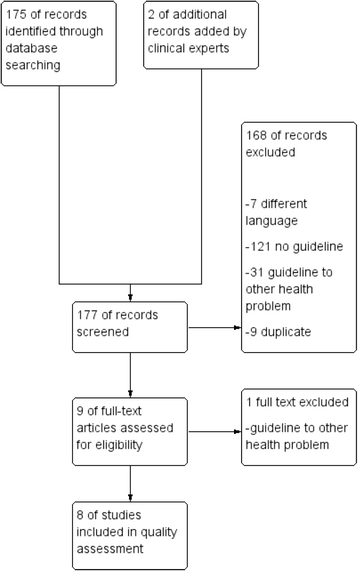Methodological quality of guidelines for management of Lyme neuroborreliosis
- PMID: 26607686
- PMCID: PMC4660677
- DOI: 10.1186/s12883-015-0501-3
Methodological quality of guidelines for management of Lyme neuroborreliosis
Abstract
Background: Many aspects of clinical management of Lyme neuroborreliosis are subject to intense debates. Guidelines show considerable variability in their recommendations, leading to divergent treatment regimes. The most pronounced differences in recommendations exist between guidelines from scientific societies and from patient advocacy groups. Assessment of the methodological quality of these contradictory guideline recommendations can be helpful for healthcare professionals.
Methods: Systematic searches were conducted in MEDLINE and databases of four international and national guideline organizations for guidelines on Lyme neuroborreliosis published from 1999-2014. Characteristics (e.g., year of publication, sponsoring organization) and key recommendations were extracted from each guideline. Two independent reviewers assessed the methodological quality of each guideline according to the Appraisal of Guidelines for Research and Evaluation II (AGREE II) tool. AGREE II scores from guidelines developed by scientific societies and from patient advocacy groups were compared across domains.
Results: We identified eight eligible guidelines of which n = 6 were developed by scientific societies and n = 2 by patient advocacy groups. Agreement on AGREE II scores was good (Cohen's weighted kappa = 0.87, 95% CI 0.83-0.92). Three guidelines, all from scientific societies, had an overall quality score of ≥ 50%. Two of them were recommended for use according to the AGREE II criteria. Across all guidelines, the AGREE II domain with the highest scores was "Clarity of Presentation" (65, SD 19%); all other domains had scores < 50% with the domain "Applicability" having the lowest scores (4, SD 4%). Guidelines developed by scientific societies had statistically significantly higher scores regarding clarity of presentation than guidelines from patient advocacy groups (p = 0.0151). No statistically significant differences were found in other domains.
Conclusions: Current guidelines on Lyme neuroborreliosis vary in methodological quality and content. Health care providers and patients need to be aware of this variability in quality when choosing recommendations for their treatment decisions regarding Lyme neuroborreliosis. No statement can be given on quality of content and validity of recommendations, as these issues are not subject to assessment with the AGREE II tool and are prone to individual interpretation of the available evidence by the corresponding guideline panels. To enhance guideline quality, guideline panels should put more emphasis on linking recommendations to the available evidence, transparency in reporting how evidence was searched for and evaluated, and the implementation of recommendations into clinical practice.
Similar articles
-
Methodological Quality Assessment with the AGREE II Scale and a Comparison of European and American Guidelines for the Treatment of Lyme Borreliosis: A Systematic Review.Pathogens. 2021 Jul 31;10(8):972. doi: 10.3390/pathogens10080972. Pathogens. 2021. PMID: 34451436 Free PMC article. Review.
-
AGREE II Quality Assessment of National and International Clinical Practice Guidelines on Prostate Cancer Management by the OPTIMA Consortium.Eur Urol Open Sci. 2024 Nov 12;70:183-193. doi: 10.1016/j.euros.2024.10.020. eCollection 2024 Dec. Eur Urol Open Sci. 2024. PMID: 39611162 Free PMC article. Review.
-
Quality of therapeutic drug monitoring guidelines is suboptimal: an evaluation using the Appraisal of Guidelines for Research and Evaluation II instrument.J Clin Epidemiol. 2020 Apr;120:47-58. doi: 10.1016/j.jclinepi.2019.10.007. Epub 2019 Oct 31. J Clin Epidemiol. 2020. PMID: 31678686
-
[Needs assessment to improve the applicability and methodological quality of a German S3 guideline].Z Evid Fortbild Qual Gesundhwes. 2018 Apr;131-132:1-7. doi: 10.1016/j.zefq.2017.09.002. Epub 2017 Sep 27. Z Evid Fortbild Qual Gesundhwes. 2018. PMID: 28958579 German.
-
Methodological quality of clinical practice guidelines with physical activity recommendations for people diagnosed with cancer: A systematic critical appraisal using the AGREE II tool.PLoS One. 2019 Apr 10;14(4):e0214846. doi: 10.1371/journal.pone.0214846. eCollection 2019. PLoS One. 2019. PMID: 30969981 Free PMC article.
Cited by
-
Lyme Neuroborreliosis.Dtsch Arztebl Int. 2018 Nov 9;115(45):751-756. doi: 10.3238/arztebl.2018.0751. Dtsch Arztebl Int. 2018. PMID: 30573008 Free PMC article.
-
Factors Associated with the Quality and Transparency of National Guidelines: A Mixed-Methods Study.Int J Environ Res Public Health. 2022 Aug 3;19(15):9515. doi: 10.3390/ijerph19159515. Int J Environ Res Public Health. 2022. PMID: 35954872 Free PMC article.
-
Methodological Quality Assessment with the AGREE II Scale and a Comparison of European and American Guidelines for the Treatment of Lyme Borreliosis: A Systematic Review.Pathogens. 2021 Jul 31;10(8):972. doi: 10.3390/pathogens10080972. Pathogens. 2021. PMID: 34451436 Free PMC article. Review.
-
Common and uncommon neurological manifestations of neuroborreliosis leading to hospitalization.BMC Infect Dis. 2017 Jan 21;17(1):90. doi: 10.1186/s12879-016-2112-z. BMC Infect Dis. 2017. PMID: 28109263 Free PMC article.
-
Lyme neuroborreliosis: do we treat according to guidelines?J Neurol. 2017 Jul;264(7):1506-1510. doi: 10.1007/s00415-017-8559-z. Epub 2017 Jul 4. J Neurol. 2017. PMID: 28676925
References
-
- Halperin JJ, Logigian EL, Finkel MF, Pearl RA. Practice parameters for the diagnosis of patients with nervous system Lyme borreliosis (Lyme disease) Quality Standards Subcommittee of the American Academy of Neurology Neurology. 1996;46:619–627. - PubMed
-
- Kullberg BJ, Berende A, van der Meer JW. The challenge of Lyme disease: tired of the Lyme wars. Neth J Med. 2011;69:98–100. - PubMed
-
- DGN . S1 Leitlinie Neuroborreliose. In: Diener H-C, Weimar C, editors. Leitlinien für Diagnostik und Therapie in der Neurologie. Stuttgart: Thieme Verlag; 2012.
Publication types
MeSH terms
LinkOut - more resources
Full Text Sources
Other Literature Sources


